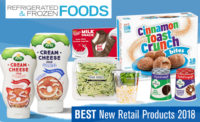When Refrigerated & Frozen Foods polled its readers about what are some key factors that play into the success of the cold food industry in 2015, 40% of the votes outlined new product and/or new category development as being the No. 1 key factor.
That’s why this year’s State of the Industry report delves deeper into what new trends are impacting each cold food category and how new product development is shaping the future of the industry.
Why Millennials matter
Millennials (ages 15-35) make up one third of the world’s population, and remain to be the most educated, accessible and well-informed consumers, according to Innova, a Chicago-based market research firm. They’re also the most loyal to brands, use social media to access coupons, share information and provide feedback.
Trends such as cleaner labels, new protein sources and hybrid products reign the list for 2015, Innova says.
Despite the proliferation of at-home cooking, the convenience factor still prevails. In fact, many of today’s new retail products come in portion-controlled packaging with resealable lids, reclosable tops and ready-to-heat-and-eat trays.
The move toward more protein-rich foods continues to rise, with everything from beverages to yogurt to breakfast items featuring more protein-rich ingredients. Innova also predicts a huge increase in fruit-based snacks and ingredients.
Another key ingredient to success with Millennials is spices. They want flavor and turn to retail products for the seasoning that can’t be found when making certain foods at home.
Same-store loyalty
Perceptions of private label products continue to transform as many of today’s private label products don quality and convenience
According to the “The Rise of Loyal Shoppers,” produced by the Private Label Manufacturers Association (PLMA), New York, the 25- to 45-year-old age group demonstrates loyalty to the same stores. While these consumers shop often and research purchases beforehand, a majority of them conduct regular grocery shopping at the same two stores.
Organic becomes more mainstream
Today’s organic tent looks a lot different than yesterday’s, according to the Organic Trade Association (OTA), Washington, D.C. It’s bigger, younger and significantly more diverse than just a few years ago, also thanks to Millennials.
OTA’s “U.S. Families’ Organic Attitudes and Beliefs 2015 Tracking Study” shows that 43% of the parents surveyed said they’re making more of an effort to use coupons, discounts and other money-saving tactics when making general food purchases, very close to the 36% watching their budget when buying organic. Meanwhile, nine in 10 families says they choose store brand products rather than brand names for conventional products, and eight in 10 say they choose store brand organic items over organic brand names.
Shrinking households change how Americans eat
Research firm Acosta, Inc., Jacksonville, Fla., produced a Hot Topics report on the evolution of eating, which stated that nine out of 10 consumers prefer to eat at home. What this means is that smaller households need smaller-sized packaged food, such as meals for two, portion-control sizes and resealable packaging.
“Today’s households feature more singles living alone, fewer children, greater diversity and more from female breadwinners,” according to Acosta.
Additionally, hybrid meals—half scratch, half pre-packaged—are on the rise, meaning meal preparation needs to be more “user friendly” for on-the-go families.
Read on to find out how these trends are used in many of today’s new retail products, or visit our online New Retail Products section here.
ADDITIONAL TRENDS AND INDUSTRY DATA PERTAINING TO THE RETAIL INDUSTRY:
How master data management reaches today's empowered consumer.
Three Happy Cows Greek Yogurt outlines how to stand out in a saturated category.
The Guiding Licensing Co. sheds some light on frozen and prepared foods trends in 2015.
Learn the benefits of working with licensed brands.




